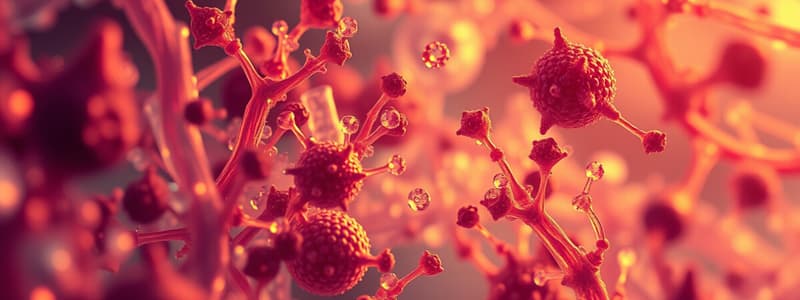Podcast
Questions and Answers
How do light microscopes work?
How do light microscopes work?
Light clarifies image and lens refracts light around the glass to produce image.
What are the advantages of light microscopes? (Select all that apply)
What are the advantages of light microscopes? (Select all that apply)
- Thin specimens can be alive (correct)
- They are the most expensive type of microscope
- They are the cheapest type of microscope (correct)
- They are the most common type of microscope (correct)
What are the disadvantages of light microscopes? (Select all that apply)
What are the disadvantages of light microscopes? (Select all that apply)
- Resolutions limited to 200nm (correct)
- Magnification limited to 2000x (correct)
- Specimens can be observed in color
- Requires staining (correct)
How do scanning electron microscopes work?
How do scanning electron microscopes work?
Scanning electron microscopes can observe live specimens.
Scanning electron microscopes can observe live specimens.
What are the advantages of scanning electron microscopes? (Select all that apply)
What are the advantages of scanning electron microscopes? (Select all that apply)
What are the disadvantages of scanning electron microscopes? (Select all that apply)
What are the disadvantages of scanning electron microscopes? (Select all that apply)
How do transmission electron microscopes work?
How do transmission electron microscopes work?
What are the advantages of transmission electron microscopes? (Select all that apply)
What are the advantages of transmission electron microscopes? (Select all that apply)
What are the disadvantages of transmission electron microscopes? (Select all that apply)
What are the disadvantages of transmission electron microscopes? (Select all that apply)
Actual size = ____
Actual size = ____
Flashcards are hidden until you start studying
Study Notes
Light Microscopes
- Use light and lenses to clarify images through refraction.
- Can view living specimens as they require thin samples.
- Cost-effective and widely accessible for general use.
- Limitations include staining requirements, magnification up to 2000x, and resolution limited to 200nm.
Scanning Electron Microscopes (SEM)
- Operate by directing a beam of electrons onto a specimen's surface to generate 3D images.
- Offer high resolution and significant magnification capabilities.
- Require specimens to be non-living, typically coated with heavy gold ions, which may damage the specimen.
- Images must be captured in a vacuum environment and are generally more costly, primarily used in research laboratories.
Transmission Electron Microscopes (TEM)
- Function by passing a beam of electrons through a thin specimen, focusing the result on a screen.
- Allow for extreme magnification, up to 500,000x, and provide superior resolution.
- Can only examine thin specimens; often employ heavy positively charged ions for staining which can harm samples.
- Designs are expensive and used mainly in research settings, producing black and white images exclusively.
Calculating Actual Size
- Actual size is determined using the formula: Image size divided by magnification.
Studying That Suits You
Use AI to generate personalized quizzes and flashcards to suit your learning preferences.




